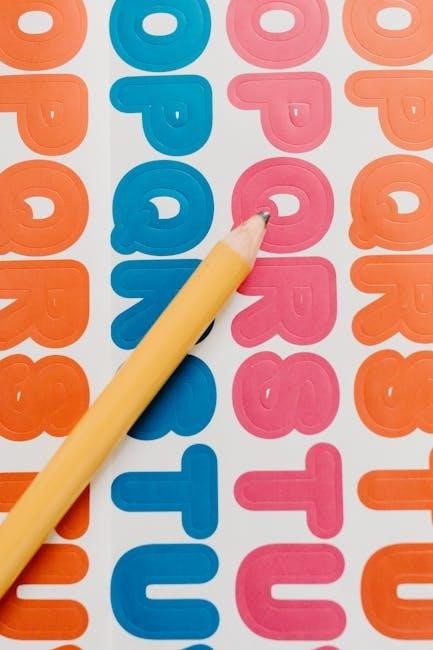Importance of a Recommendation Letter for Students
A recommendation letter from a teacher vouches for a student’s academic abilities, character, and dedication, enhancing their credibility for educational and professional opportunities.
1.1 Academic and Professional Opportunities
A recommendation letter from a teacher significantly boosts a student’s chances for academic and professional opportunities. It highlights their strengths, making them stand out for university admissions, internships, and job placements. A strong letter underscores their capabilities and character, proving crucial in competitive environments.
1.2 Building Credibility for the Student
A recommendation letter from a teacher builds credibility by providing insights into the student’s academic performance, character, and work ethic. Specific examples and personal anecdotes validate their abilities, creating a trustworthy profile for admissions committees, employers, or scholarship reviewers to assess their potential.
1.3 Showcasing Student’s Strengths and Achievements
A recommendation letter highlights a student’s academic excellence, extracurricular involvement, and personal qualities. By including specific examples of their accomplishments, the letter demonstrates their capabilities, dedication, and potential, making them stand out to reviewers and strengthening their application for colleges, jobs, or scholarships.
Structure of a Recommendation Letter
A recommendation letter typically includes an introduction, a body with specific examples, and a conclusion. It outlines the teacher-student relationship, highlights achievements, and ends with contact details.
The introduction establishes the teacher-student relationship, detailing how long and in what capacity the teacher has known the student. This context provides credibility and sets the tone for the letter.
2.2 Body with Specific Examples and Qualities
The body highlights the student’s strengths, academic achievements, and personal qualities, supported by specific examples. It showcases their work ethic, leadership skills, and contributions, providing a well-rounded view of their capabilities and character.
2.3 Conclusion and Contact Information
The conclusion reaffirms the teacher’s confidence in the student, summarizing their potential and suitability for the opportunity. It ends with a polite offer to provide additional information, followed by the teacher’s contact details for further inquiries.

Writing Tips for a Teacher Recommendation Letter
Be specific about the student’s qualities and achievements, use examples, maintain a professional tone, and consider using templates for structure. Proofread thoroughly.
3.1 Personalizing the Letter for the Student
Personalize the letter by highlighting the student’s unique strengths, achievements, and qualities. Tailor the content to reflect the student’s specific experiences and your relationship with them, ensuring it stands out and feels genuine.
3.2 Highlighting Academic and Extracurricular Achievements
Emphasize the student’s academic performance, such as high grades or projects, and their involvement in extracurricular activities. Provide specific examples to demonstrate their leadership, teamwork, and dedication, showcasing a well-rounded individual.
3.3 Maintaining Professional Tone and Format
Use a formal tone, avoiding slang and informal language. Ensure proper structure with a clear introduction, body, and conclusion. Include your contact information for follow-up. Proofread for grammar and clarity to present a polished, professional document that reflects well on both you and the student.
Templates and Samples for Recommendation Letters
Downloadable PDF and Word templates provide structured formats for crafting polished recommendation letters, ensuring consistency and professionalism while personalizing content for individual students.
4.1 Downloadable PDF Templates for Teachers
Free downloadable PDF templates simplify the process of writing recommendation letters, offering customizable formats with placeholders for student details, specific examples, and contact information. These templates ensure a professional tone and structure, saving time while maintaining consistency and clarity in the recommendation letter.
4.2 Customizable Word Doc Templates
Customizable Word Doc templates provide flexibility, allowing teachers to easily personalize recommendation letters with specific student details, achievements, and anecdotes. These editable templates ensure a professional format while enabling quick adjustments to tailor the letter for individual students, saving time and maintaining a polished appearance.
4.3 Examples of Well-Written Letters
Examples of well-written recommendation letters provide clear structure, tone, and content guidance. They demonstrate how to effectively highlight a student’s work ethic, academic strengths, and personal qualities, offering a professional and compelling endorsement that supports the student’s future opportunities.

Common Mistakes to Avoid in Recommendation Letters
Common mistakes include vague language, insufficient details about the student’s performance, and poor formatting, which can weaken the letter’s impact and credibility.
5.1 Overly Generic Statements
Overly generic statements lack specific details about the student’s achievements, making the letter less impactful. Avoid vague praise and instead include concrete examples of academic performance, skills, or personal qualities to provide a meaningful endorsement.
5.2 Lack of Specific Examples
Avoid letters that lack specific examples, as they fail to highlight the student’s strengths. Include clear instances of their achievements, skills, or character traits to make the recommendation credible and compelling for academic or professional opportunities.
5.3 Poor Formatting and Grammar
Poor formatting and grammar can undermine the professionalism of a recommendation letter. Ensure the document is well-structured, free of typos, and grammatically correct to maintain credibility. A polished letter reflects positively on both the student and the recommender, making the endorsement more impactful and professional.

Examples of Recommendation Letters
View downloadable PDF examples of recommendation letters for students, including templates for academic admissions, employment, and scholarships, tailored to highlight a student’s strengths and achievements effectively.
6.1 Sample Letter for Academic Admission
A sample letter for academic admission highlights the student’s academic strengths, character, and achievements, providing a professional endorsement. It includes specific examples of academic excellence and personal qualities, demonstrating the student’s readiness for higher education. The letter is typically written in a formal tone and supports the student’s application effectively.
6.2 Sample Letter for Employment
A sample letter for employment highlights the student’s work ethic, skills, and personal qualities relevant to the job. It details their role in projects or jobs, showcasing teamwork, problem-solving, and dedication. The letter serves as a professional endorsement, helping the student stand out in competitive employment opportunities.
6.3 Sample Letter for Scholarships
A sample letter for scholarships emphasizes the student’s academic achievements, personal strengths, and community involvement; It highlights their potential to excel and contribute positively, supported by specific examples of leadership, initiative, and dedication, making a compelling case for scholarship consideration.

Customizing the Letter for Different Purposes
Customizing a recommendation letter ensures it aligns with the student’s goals, whether for college, employment, or scholarships, by highlighting relevant strengths and experiences.
7.1 Tailoring for College Admissions
A recommendation letter for college admissions should highlight the student’s academic achievements, extracurricular involvement, and personal qualities. Using a PDF template ensures professionalism and clarity, showcasing the student’s readiness for higher education and aligning the letter with the specific requirements of the institution.
7.2 Tailoring for Job Applications
A recommendation letter for job applications should emphasize the student’s relevant skills, work ethic, and practical experiences. Using a PDF template, highlight specific achievements and qualities that align with the job description, demonstrating how the student’s abilities will benefit the employer and the role they are applying for.
7.3 Tailoring for Scholarships and Awards
When writing a recommendation letter for scholarships, highlight the student’s academic excellence, leadership, and community involvement. Use a PDF template to ensure a professional format, emphasizing qualities that align with the scholarship criteria. Provide specific examples to demonstrate the student’s potential and suitability for the award or financial aid opportunity.
Digital Formats and Submission
Using PDF format ensures professionalism and compatibility. Submitting letters online through portals is efficient. E-signing tools add authenticity, while digital templates streamline the process for quick customization and delivery.
8.1 PDF Format for Professionalism
PDF format is widely regarded as the most professional and reliable choice for recommendation letters. It ensures consistent formatting and readability across devices, making it ideal for official submissions. Downloadable PDF templates are easily accessible and maintain the letter’s integrity, ensuring a polished and credible presentation of the student’s qualifications and achievements.
8.2 Submitting Letters Online
Submitting recommendation letters online is efficient and secure, often through university portals or email. PDF format is preferred due to its professional appearance and consistency. Online submission streamlines the process, reduces delays, and ensures confidentiality, making it a convenient option for both teachers and students.
8.3 E-Signing and Digital Templates
E-signing and digital templates simplify the recommendation letter process. Teachers can use platforms to create, customize, and sign letters electronically, ensuring professionalism and efficiency. Digital templates offer pre-designed formats, saving time and ensuring a polished appearance, while e-signatures add authenticity and convenience.
Best Practices for Teachers
Understanding the student’s goals, requesting detailed information, and maintaining organized records ensure tailored, impactful recommendation letters that highlight the student’s strengths and achievements effectively.
9.1 Understanding the Student’s Goals
Teachers should discuss the student’s aspirations and objectives to craft a letter that aligns with their future plans, ensuring the recommendation is relevant and impactful for academic or professional opportunities.
9.2 Requesting Necessary Information
Teachers should ask students for details like achievements, grades, and extracurricular activities to include specific examples in the recommendation letter, making it personalized and stronger for their applications.
9.3 Keeping Records for Future Requests
Maintaining organized files of student achievements, drafts, and correspondence ensures consistency and efficiency when writing future recommendation letters, allowing teachers to easily access relevant details and provide accurate, personalized references.
How to Request a Recommendation Letter
Students should approach teachers politely, provide detailed information about their goals, and allow sufficient time for the letter to be written, ensuring a thoughtful and personalized recommendation.
10.1 Providing Necessary Details to the Teacher
Inform the teacher about the purpose of the letter, deadlines, and any specific requirements. Share details about the student’s academic achievements, extracurricular activities, and personal strengths to help craft a well-informed and personalized recommendation.
10.2 Giving Adequate Time for the Teacher
Provide the teacher with sufficient time to draft and refine the letter, ideally 4-6 weeks before the deadline. This allows them to thoughtfully gather information, write a detailed recommendation, and avoid rushed or generic content.
10.3 Expressing Gratitude After Submission
After the teacher submits the recommendation letter, the student should express sincere gratitude through a thank-you note or email. Acknowledging the teacher’s time and effort demonstrates respect and appreciation for their support in the student’s academic or professional journey.